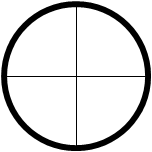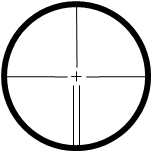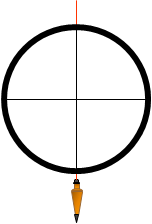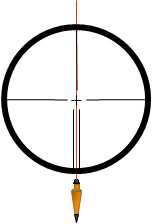1. Instrumental
a. Maladjustment
TSI instrumental errors are described in Topic XV. Chapter G. Theodolite and Total Station. Instrumental errors are almost all systematic and most can be eliminated by appropriate measurement procedures.
Instrumental errors and compensation for support equipment are described in Topic XV. Chapter B. The Basic Stuff. While most of these also behave systematically, there can be some random effects such as loose tripod hardware.
b. Crosshair design
(1) Description
In early telescope-based surveying instruments, crosshairs consisted of spider web stands attached to a reticule ring. In addition to their delicacy, they offered the surveyor only a single sighting option: a solid line, Figure D-1(a). As instrumentation and optics evolved, crosshairs eventually became etched lines on optically flat glass plates. Etching allows for more creative and effective crosshair designs, Figures D-1(b) and D-1(c) being two examples.
|
(a) |
(b) |
(c) |
| Figure D-1 Crosshair Styles |
||
A narrow sight mark, such as a plumb bob line, at a longer distance may appear narrower than the vertical solid hair causing some pointing error - the hair obscures the string. Using a split hair design, such as Figure D-1(c), allows the operator to see both the sight mark and the hair. It is often easier to center the mark between hairs than try to make it coincide with a single one, Figures D-2(a) and (b).
|
(a) |
(b) |
| Figure D-2 Sighting Plumb Line |
|
(2) Behavior
Random.
(3) Compensation
Modern instruments use crosshair design(s) that help make target sighting easier. Target selection can still affect sighting error and is discussed under Personal error sources.




